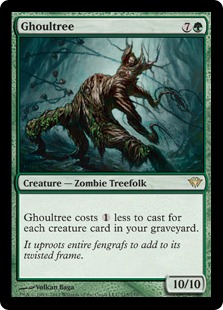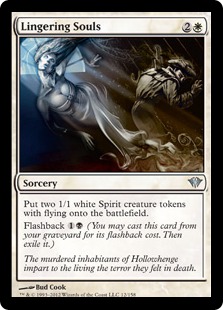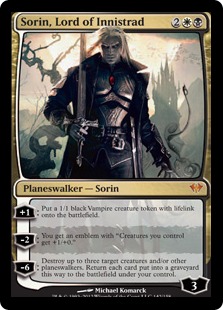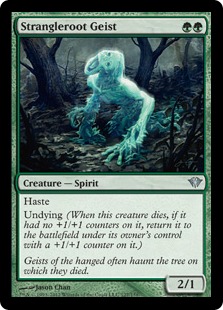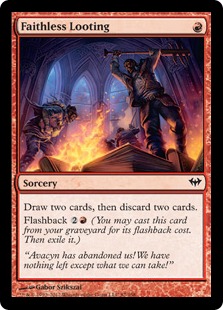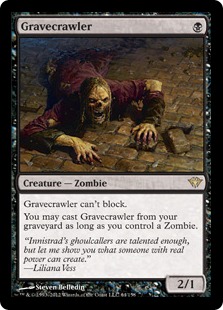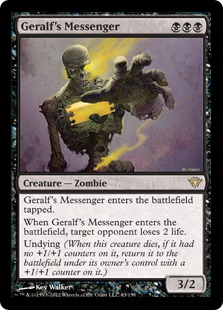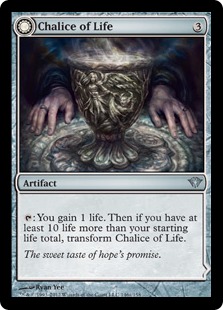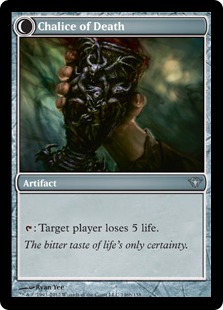Note: Given the delay between the release of the Dark Ascension spoiler and the release of this article, I decided that the best way to approach the set with a fresh viewpoint was simply to take a brief hiatus from reading articles that either a) assessed the new set’s impact on Constructed formats or b) provided analyses of individual cards. While this lessens the extent to which I can hedge my bets by comparing my estimates to those of the “hive mind” before finishing my article, I think that it provides a better service to the community, as a whole, to have different perspectives at the outset that don’t cannibalize each other.
That having been said, here’s a “first pass” at the cards that I think will make waves in Constructed in the upcoming months.
10) Ghoultree
Our first entry in the list is a contender in ISD Block Constructed but may eventually make its way into Standard when the format rotates in the fall. In addition to the amazingly evocative image, which contains shades of the movie 300, this is one of the few cards for which, in terms of flavor, we might best be served by avoiding extensive contemplation. Eight mana is a fairly hefty price to pay for a 10/10 creature without trample, and so the extent to which this card is playable is directly proportional to the extent to which its cost can be reduced. If we compare it to Boneyard Wurm, we can get a better picture of how good it might be:
3 creatures in graveyard—Boneyard Wurm (1G for a 3/3)—Ghoultree (4G for a 10/10)
4 creatures in graveyard—Boneyard Wurm (1G for a 4/4)—Ghoultree (3G for a 10/10)
…
7 creatures in graveyard—Boneyard Wurm (1G for a 7/7)—Ghoultree (G for a 10/10)
If we construct a shell in which we expect to be able to place a lot of creatures in the graveyard, then Ghoultree compares favorably to Boneyard Wurm. With six or seven creatures in the yard, it’s strictly better and doesn’t get worse if creatures are removed/exiled from the graveyard after it’s in play. Even with only four creatures in the graveyard, it’s still a 10/10 “Hill Giant” to go with our 4/4 “Grizzly Bears.” A basic U/G/b shell for Block Constructed easily could adapt Ghoultree along with the new blue instant Thought Scour and a miser’s Wild Hunger to compensate for the lack of trample:
Creatures (23)
- 3 Boneyard Wurm
- 4 Avacyn's Pilgrim
- 3 Deranged Assistant
- 2 Kessig Cagebreakers
- 3 Splinterfright
- 4 Armored Skaab
- 4 Ghoultree
Lands (13)
Spells (24)
- 5 Forest
- 3 Island
- 3 Mulch
- 1 Spider Spawning
- 2 Sever the Bloodline
- 4 Dream Twist
- 2 Gnaw to the Bone
- 3 Thought Scour
- 1 Wild Hunger
Sideboard

9) Lingering Souls
This card would be much higher on the list if it had a flashback cost with either blue, green, or white mana rather than black. The fact that it’s strictly worse than Midnight Haunting unless we can generate black mana means that it’s a very archetype specific card, though it will almost certainly see play in Standard. Currently, the strongest token strategy in Block Constructed seems to be G/W because of Mayor of Avabruck and Garruk Relentless. The extent to which B/W Tokens is viable in Standard given that G/W currently is “not” largely will depend on the strength of this card and of the next card on this list.
8) Sorin, Lord of Innistrad
In the right context, this card seems better than Elspeth, Knight-Errant. While the mana cost is somewhat more difficult to pay (although WW may be nearly as difficult as B/W in a variety of strategies), the first ability is, for most intents and purposes, strictly better than Elspeth’s. The second ability debatably is worse than Elspeth’s in many circumstances, though. First, and most obviously, it’s a “minus” ability rather than a +1 (something many players surprisingly forget when comparing the two cards). In addition, Sorin’s second ability doesn’t provide evasion, and it requires at least three creatures to be attacking to provide equivalent power to Elspeth’s (at least with the first emblem). However, in a long, creature-based matchup, the fact that Sorin’s emblems stack may be incredibly relevant, especially given their synergy with his tokens’ lifelink. Finally, his -6 ability obviously is game-changing if it resolves, but in many cases the use of his emblem ability and his ultimate will be mutually exclusive. That having been said, some sort of W/b/x(?) Tokens almost certainly will be viable. Off the top of my head, there are several ways in which this might go…
Creatures (10)
Planeswalkers (6)
Lands (14)
Spells (30)

The three copies of Sword of War and Peace are a concession to the expectation that there probably will be a lot of white blockers in the upcoming Standard format, and we will be well-served by the ability to push past them to an extent. The synergy between Bloodline Keeper and Sorin, Lord of Innistrad should not be overlooked because the two cards together quickly can flip Bloodline Keeper for some incredible pressure on the board. It may also be the case that Faith’s Shield would be good in this deck in some number.
If we’d rather integrate Sorin into the current “best” tokens deck from Block Constructed and try to port it to Standard, we’re probably looking at a “Beach House” style deck that looks to abuse Gavony Township. A first take might look as such:
Creatures (13)
Planeswalkers (8)
Lands (15)
Spells (24)

7) Strangleroot Geist
*sigh* If only this card weren’t green… the ability to play a hasted two-power attacker for two that returns to play with a +1/+1 counter if it’s killed is incredibly powerful, but is limited in this case by the extent to which it fits into a shell that “does something” (i.e., isn’t green). That having been said, the card is probably too good to go an entire Standard rotation without seeing play, and so we might look for synergies that make it especially potent. Both Birthing Pod and Garruk Relentless seem to work well with undying. The Birthing Pod deck may be more powerful, but it is also more obvious how to build the shell. A B/G “Rock” style deck in the style of the old Doran decks might also be viable.
Creatures (22)
- 4 Solemn Simulacrum
- 1 Grave Titan
- 1 Primeval Titan
- 1 Wurmcoil Engine
- 1 Massacre Wurm
- 3 Viridian Emissary
- 3 Bloodgift Demon
- 4 Strangleroot Geist
- 4 Black Cat
Planeswalkers (6)
Lands (18)
Spells (12)

On paper, this list looks weaker than the “tokens” variants using the same colors, so perhaps it needs a little something extra to propel it past its closest contenders. It may also simply be the case that non-Pod decks using Strangleroot Geist simply aren’t as powerful as Pod decks.
6) Faithless Looting
“Screw it, let’s break stuff.” This is one of the more philosophical cards in the set because it applies a typical “Goblins” trope to Humans. The card begs the oft-asked question, “In the absence of an objective rule structure, do we all become Squee?” The most obvious use of the card is to strengthen the waning popularity and power of U/R Storm in Modern (for a good list pre-Faithless Looting, see the list that I cited in my last article). It’s also possible that it could see play in a Grixis Control shell in Standard, but it probably isn’t better than Desperate Ravings. It would also have worked well in the old U/R Delver/Burn deck, but that increasingly has been supplanted by U/W variations. If Legacy Dredge isn’t totally demoralized by Grafdigger’s Cage, it might also adjust its manabase slightly to include Faithless Looting.
5) Gravecrawler
In the context of a Standard format, the closest comparison we can find for Gravecrawler is probably Bloodghast. Granted, the link is tenuous. Bloodghast doesn’t require mana to return to the battlefield, which is a significant advantage over Gravecrawler in the very early portions of the game. However, the presence of a Zombie on the board is a less onerous requirement, long-term, than landfall, and it is likely that Gravecrawler always can be “rebought” when needed. Gravecrawler is also contextually weaker than Bloodghast because there is no Kalastria Highborn/sacrifice outlet with which to abuse it (although Altar’s Reap is a good start). That having been said, it is likely that some form of Mono-Black Aggro with Gravecrawler will become at least a Tier 2 deck in Standard, partly because of the inclusion of…
4) Geralf’s Messenger
As a 3/2 creature with built-in recursion, comparisons between Geralf’s Messenger and Kitchen Finks are inevitable. On defense, the fact that this creature comes into play tapped does not play well with the fact that Gravecrawler can’t block. On offense, though, the fact that it “trades up” rather than down makes it a more threatening beater than Kitchen Finks, and the third point of toughness on the “Undead” form may be especially relevant against the plethora of tokens and Spirits that may soon occupy Standard. In addition, dealing two damage upon entering the battlefield is a significant enough effect that some players have been willing to run a vanilla 2/2 for WW (Inquisitor Exarch) in an aggressive shell in order to get it. A loose Mono-Black Aggro (Zombies!) shell might look like this:
Creatures (23)
- 4 Cemetery Reaper
- 4 Phyrexian Obliterator
- 4 Diregraf Ghoul
- 4 Gravecrawler
- 4 Geralf's Messenger
- 3 Highborn Ghoul
Lands (24)
- 20 Swamp
- 4 Inkmoth Nexus
Spells (13)

One of the primary questions when developing a deck like this is whether to include Inkmoth Nexus. The pure Swamp route is better in terms of consistently hitting the numerous BB, BBB, and BBBB costs in the deck, as well as generating the most powerful Lashwrithe possible. However, Inkmoth Nexus + Lashwrithe is still one of the most threatening creatures in Standard, and even though this deck doesn’t synergize well with the poison counters, it’s a reasonable plan B that is powerful enough to merit a slight dilution of the mana base. The deck may also want some number of cards like Liliana of the Veil and/or Skinrender. It might also want to “get cute” and include blue for Diregraf Captain, Grimgrin, Corpse Born, and/or Necrotic Ooze in order to combo out on occasion.
3) Chalice of Life | Chalice of Death
Okay. I recognize that I’m going out on a very thin limb here… but we have been tapping Millstones for years now to deplete our opponents’ libraries 1/30th at a time. Given the relative power of current lifegain mechanics, it seems like we should be able to flip this card into Chalice of Death without too much effort, at which point it becomes a fairly hard-to-remove win condition for the right kind of control decks. The downside is that as a control deck, we likely are being attacked relentlessly, making the 30-life threshold difficult to hit in reality. However, with a single activation of Martyr of Sands… we probably can flip it. Unfortunately, the Modern format is too proactive for a slow grind. Is there a deck shell waiting for this card? Honestly, I’m not entirely sure, and, to date, I haven’t found a way that it does anything in a format like Modern better than current cards. This card is probably a pipe dream, but I really hope that someone finds a way to make it work.
2) Grafdigger’s Cage
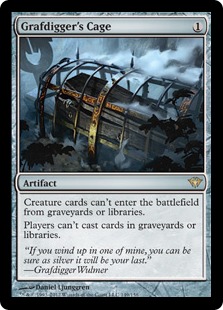
This is an ideal sideboard card—it clearly hoses specific strategies, and there is little ambiguity about whether or not to board it in in most circumstances. In the event that a particular strategy that fully relies on one or more of these mechanics, Grafdigger’s Cage will be the go-to answer. As such, while it will never hit exorbitant prices because it’s not a pervasive maindeck card, it will probably retain some meaningful value. Off the top of my head, in Standard and Modern, it prevents some or all of the use of the following cards:
Every flashback card (in particular…)
- Ancient Grudge
- Desperate Ravings
- Dread Return
- Dream Twist
- Faithless Looting
- Forbidden Alchemy
- Mystical Teachings
- Past in Flames
- Think Twice
- Unburial Rites
Snapcaster Mage
Narcomoeba
Reanimate
Exhume
Every undying creature
Every persist creature
Gravecrawler
Ichorid
Ashen Ghoul
Proclamation of Rebirth
Polymorph
Probably quite a few others…
1) Drogskol Captain

Hexproof is a very non-interactive creature mechanic, making it one of the more powerful mechanics to have been printed in recent years. The ability to play a U/W Tempo game against other decks that simply can’t target our creatures is unfair, and if a reasonable U/W Spirits deck can emerge following Dark Ascension’s release, then it is likely that this card will be the centerpiece, playing a role similar to that played by Scion of Oona in the Standard Fae decks of yore. Importantly, Drogskol Captain is also a 2/2 flyer for three mana, meaning that we’re not just paying for an effect, we’re also paying for a threat.
Creatures (18)
Lands (10)
Spells (32)

There is a 99.9% change that this shell has some significant problems. It’s a bit cluttered in terms of what it wants to do on the third turn, and it is unclear that the creatures selected for this build are optimal (how good is Niblis of the Urn, for instance? Might we include it as a means of pushing through blockers?). It also is competing with a similar deck using a tokens theme that might end up being more powerful and consistent.
Regardless of the direction in which the format goes in the next few weeks, Dark Ascension looks like it will shake up the metagame, though it may take a few weeks of tournaments for the new frontrunners to emerge.

